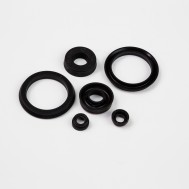NBR, also known as Nitrile or Buna-N, is one of the most widely used and economical elastomers. This material offers excellent sealing capabilities at a very low cost. NBR is a copolymer of butadiene and acrylonitrile, and depending on the application, the proportions of acrylonitrile can vary from 14% to 50%. The higher acrylonitrile content, the greater resistance to oil and fuel.
NBR Formulation
When formulating NBR compounds, filler, plasticizer, antioxidant or antiozonant, zinc oxide, accelerator, and vulcanizing agents may be used to increase specific sealing properties of the material. When it comes to filler, carbon black is typically used in standard NBR compounds. Altering the amount of carbon black will change the hardness of the final compound.
Plasticizers increase the processability and modify physical properties of the final compound. Some of the modifications include lower hardness, improved flexibility, and low temperature performance. Sulfur is commonly used as a curing agent for NBR compounds. For sulfur cure systems, vulcanizing agents and accelerators are used to speed up the reaction rate between NBR and sulfur.
Properties and Advantages
NBR is an ASTM D1418 designation. These standard compounds have a working temperature range of -40°F to 257°F and hardness range of 40 to 90 Shore A. NBR compounds can be formulated to offer additional temperature ranges from -85°F to 275°F.
NBR features excellent resistance and mechanical properties, including:
- Resistance to petroleum-based oils and fuels, silicone greases, hydraulic fluids, water and alcohols
- Low compression set
- High tensile strength
- High abrasion resistance
- Low gas permeability
While NBR offers great resistance to many chemicals and solutions, there are some limitations to be aware of. NBR should have limited contact with:
- Ozone, sun exposure, rain, wind
- Highly aromatic fuels
- Non-polar solvents
- Glycol-based brake fluids
Typical Applications
Because of NBR’s compatibility with oils and fuels, NBR seals are commonly used in the automotive industry. However, NBR is a go-to material for oil applications of any kind. NBR is also commonly used in applications such as:
- Low temperature military applications
- Off-roading equipment
- Marine devices
- Aircraft fuel systems
NBR can also be formulated to meet FDA standards, which increases the number of ways to apply NBR o-rings.
Want to learn more about NBR o-rings?
Contact an engineer today.
